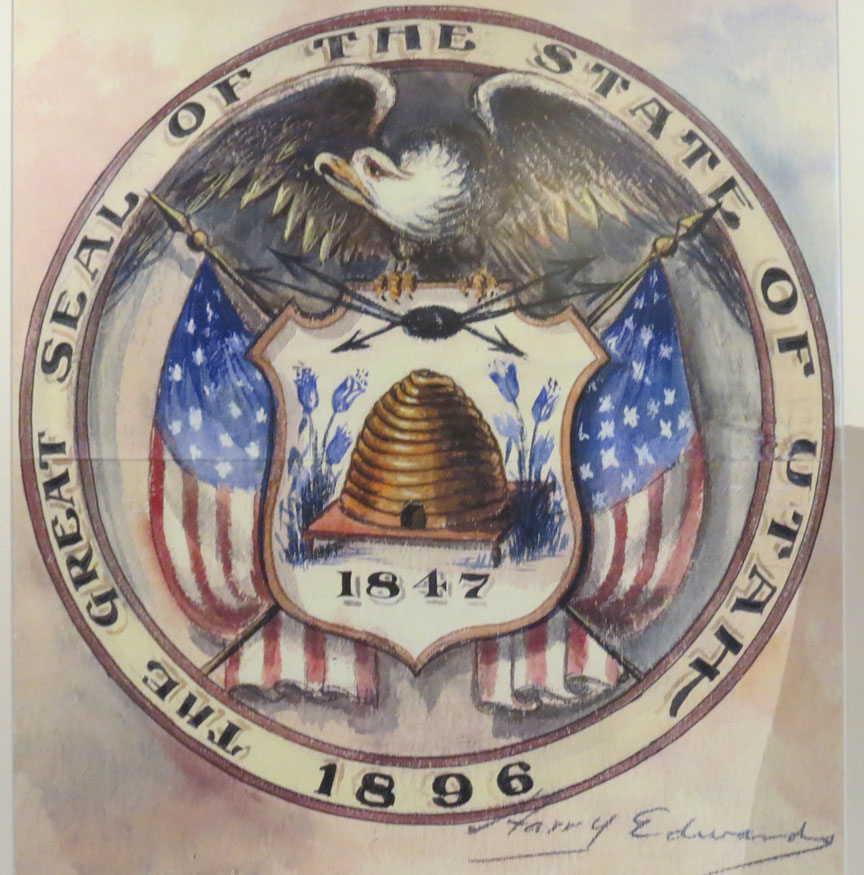

Utah State Capitol
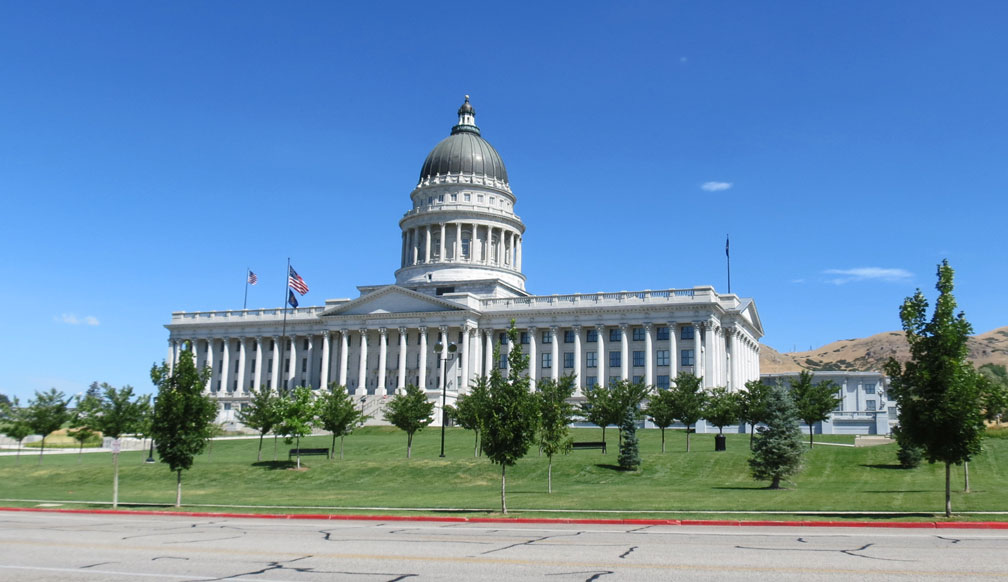
Utah State Capital
The Utah State Capitol is the house of government for the U.S. state of Utah. The building houses the chambers of the Utah State Legislature, the offices of the Governor of Utah and Lieutenant Governor of Utah, along with other supporting offices for the Government of Utah. The capitol is the main building of the Utah State Capitol Complex, which is located on Capitol Hill, overlooking downtown Salt Lake City.
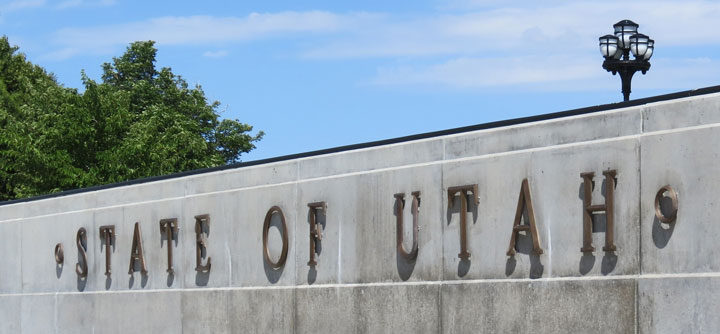
The Neoclassical revival, Corinthian style building was designed by architect
Richard K. A. Kletting, and built between 1912 and 1916. The building was added
to the National Register of Historic Places in 1978. Beginning in 2004 the
capitol experienced a major restoration and renovation project. The project
added two new buildings to the capitol complex, while restoring many of the
capitol's public spaces to their original appearance. One of the largest
projects during the renovation was the addition of a base isolation system which
will allow the building to survive as much as a 7.3 magnitude earthquake. After
completion of the renovations, the building was rededicated and resumed normal
operation in January 2008.

The capitol's architect was inspired by Classical architecture, and some local newspapers compared the early designs to Greece's Parthenon. Many of the building's details rely on the Corinthian style, in which formality, order, proportion and line are essential design elements. The building is 404 feet (123 m) feet long, 240 feet (73 m) feet wide, and the dome is 250 feet (76 m) high.

The exterior is constructed of Utah granite (Quartz monzonite mined in nearby
Little Cottonwood Canyon), as are other Salt Lake City landmarks such as the
Salt Lake Temple and LDS Conference Center. The stone facade is symmetrical,
with each side being organized around a central pedimented entrance. Fifty-two
Corinthian columns, each 32 feet (9.8 m) tall by 3.5 feet (1.1 m) in diameter
sitting on an exposed foundation podium, surround around the south (front), east
and west sides of the capitol.


The building's interior has five floors (four main floors and a basement). Most
of the basement level now contains the base isolators, which are meant to make
the building more resistant to earthquakes. The capitol is decorated with many
paintings and sculptures of Utah's history and heritage, including statues of
Brigham Young, first territorial governor, and Philo T. Farnsworth, Utah native
and a developer of television. The floors are made of marble from Georgia.
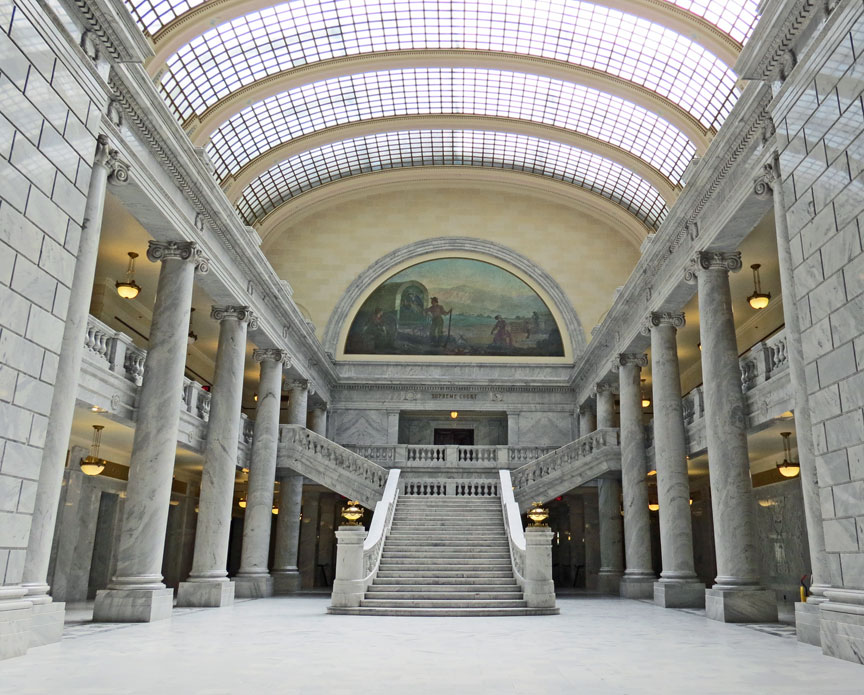
The capitol's main floor
The first floor, or ground floor, was the first completed and has the least amount of decorative finish work. The exterior stairs on the east and west ends of the building lead to this level, versus the front steps which lead directly to the 2nd floor. When first completed in 1916 the ground floor was mostly a vast, open exhibit space spanning the entire length of the building, while offices were built in the four corners of this level. The ceiling beneath the rotunda above is made of glass (which also serves as the floor above), and allows light from the 2nd floor to illuminate the ground floor also. Over time the large open areas of the ground floor were walled in and divided, extending the offices into the public space. Now the ground floor still contains many of the capitol's exhibits, and includes a small visitors center and gift shop.
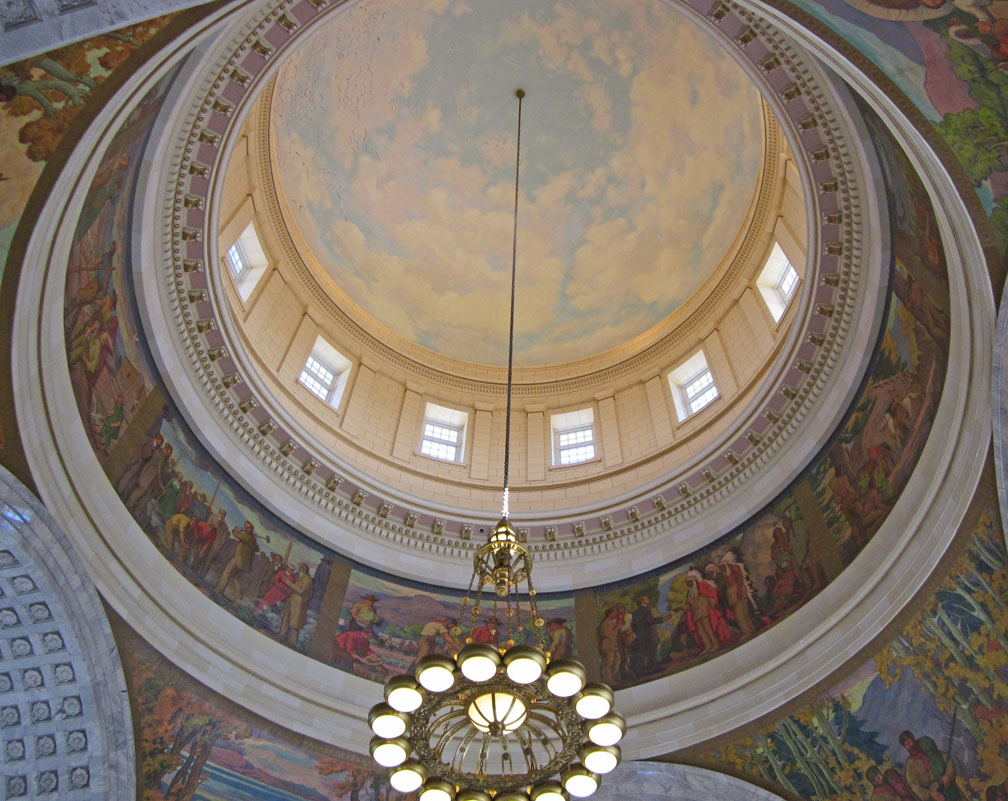
The capitol's rotunda and dome interior
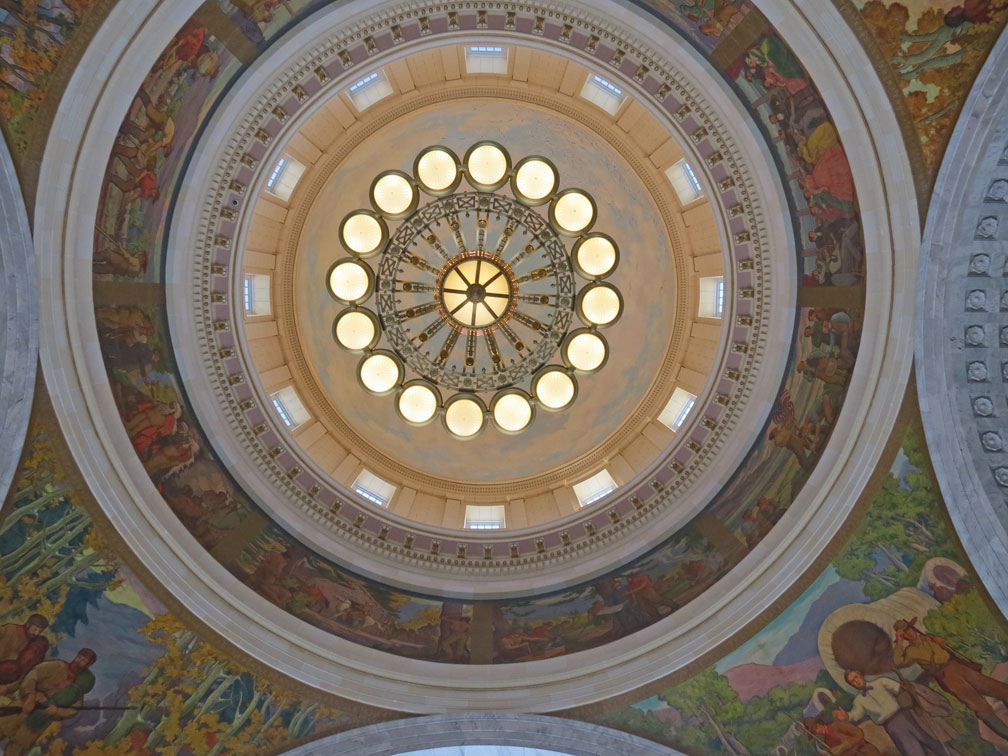
The building's second floor, often referred to as the main floor, has retained much of its historic appearance over the years. This floor also serves as the first level of the three-story-tall rotunda and atrium area. The rotunda is directly in the center of the building, under the dome. The interior ceiling of the dome, which reaches 165 feet (50 m) above the floor, includes a large painting by artist William Slater. The mural includes seagulls flying amongst clouds, and was choose because the California gull is Utah's official state bird and represents the Miracle of the gulls from Utah's history. Also within the dome is a cyclorama, with eight scenes from Utah's history, including the driving of the Golden Spike and the naming of Ensign Peak; the characters in the scenes of the cyclorama stand approximately 10 feet (3.0 m) high. When the capitol was originally opened in 1916 the cyclorama was blank, and was not painted until the 1930s, as a Works Progress Administration (WPA) project.
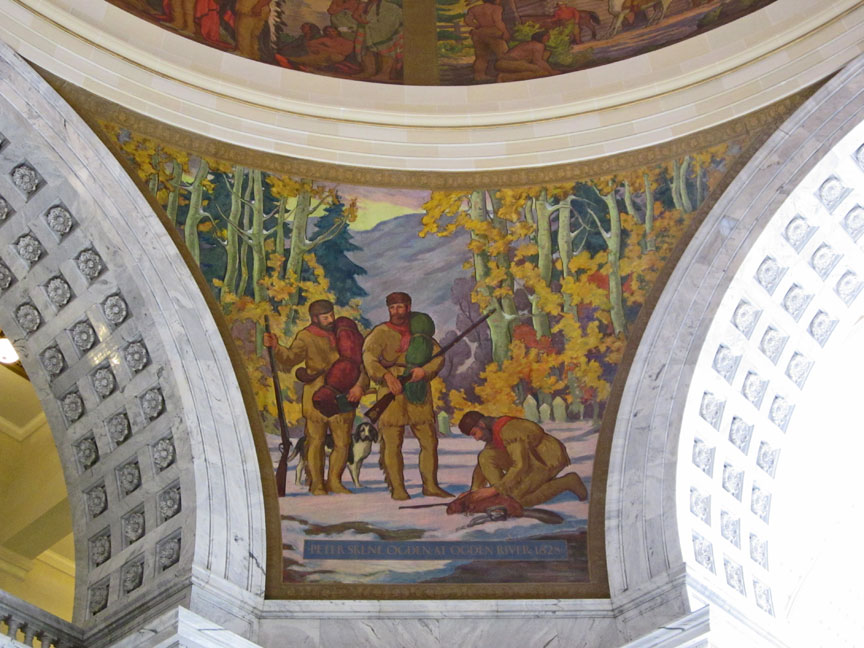
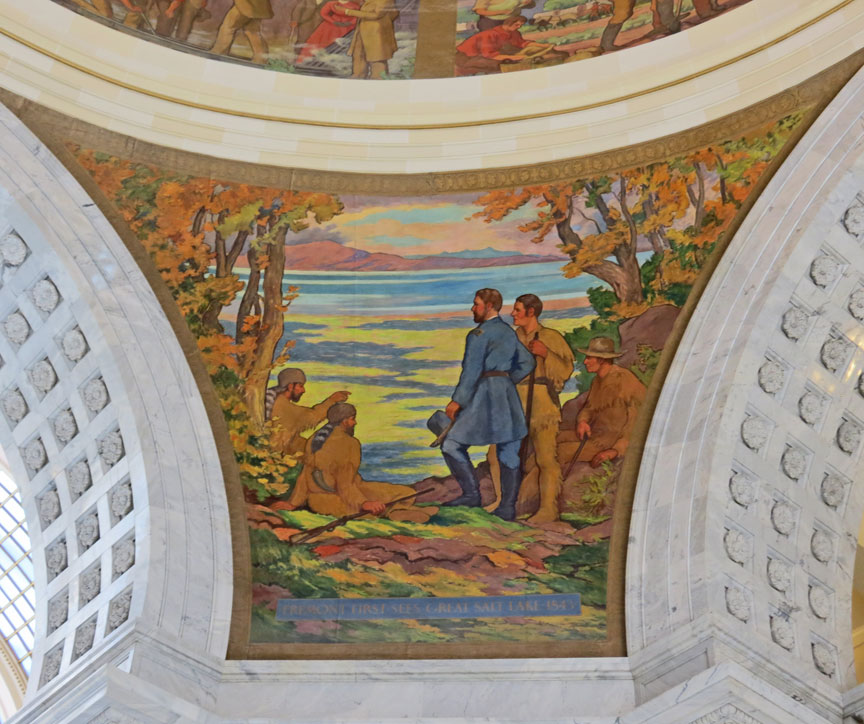
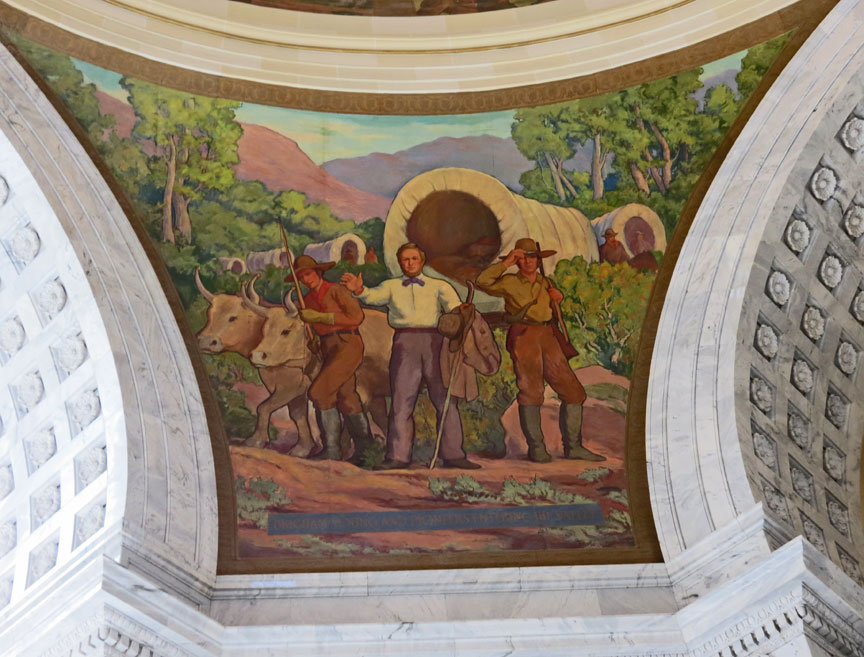
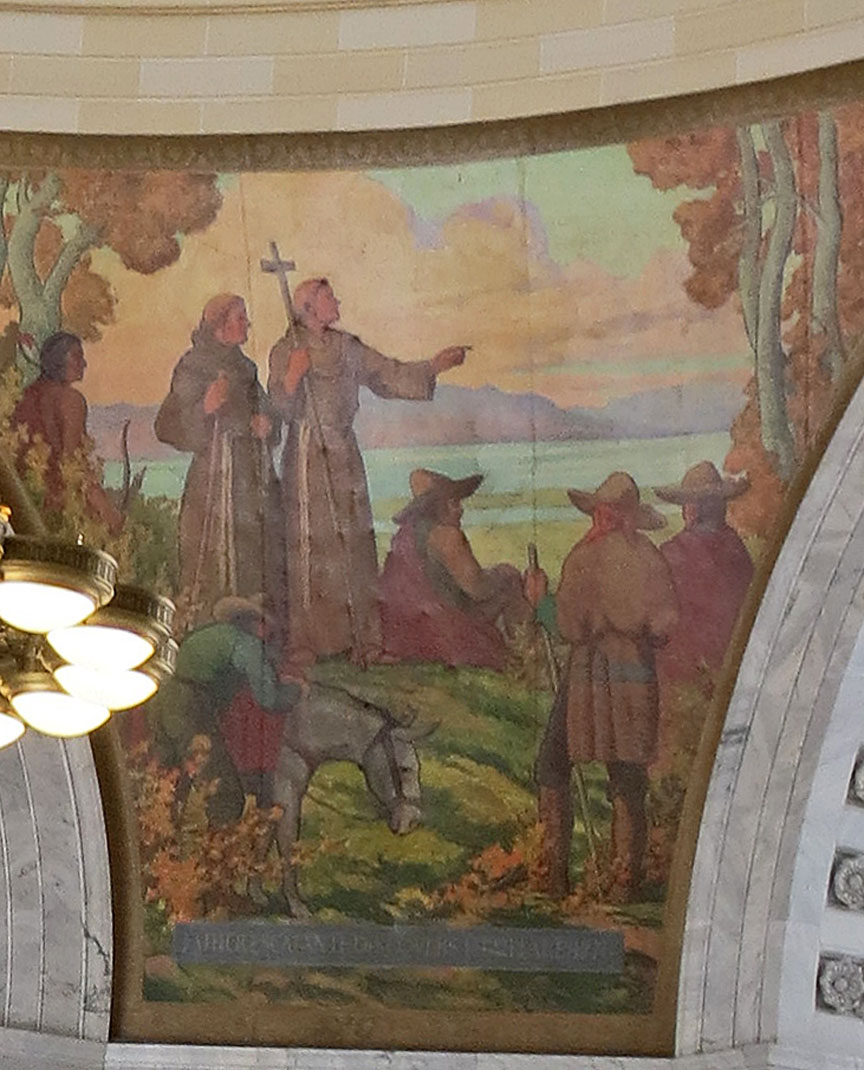
The dome is supported by marble covered, coffered arches, which site on four
triangular shaped supports. The coffered arches are each painted with a scene
from Utah's history including the exploration of Utah by John C. Frémont, the
Dominguez-Escalante Expedition, the fur trapping done by Peter Skene Ogden and
lastly the arrival of the Mormons Pioneers led by Brigham Young. At the bottom
of the four supports surrounding the rotunda are niches containing statues. The
niches are original to the building, but until the restoration they remained
empty. Prior to the renovations, three artists, Eugene L. Daub, Robert Firmin,
and Jonah Hendrickson were commissioned to create statues to fill the empty
niches. The four statues, each approximately 11 feet (3.4 m) tall and known
collectively as "The Great Utahs" represent Science and Technology, Land and
Community, Immigration and Settlement, along with the Arts and Education.
Suspended from the dome's ceiling is the original chandelier weighing 6,000 lb
(2,700 kg) (The chain supporting it weighs an additional 7,000 lb (3,200 kg)).
The chandelier is an exact copy of one hanging in the Arkansas State Capitol,
and during the restoration process Arkansas sent several, one of a kind, al–al
glass diffusers to Utah to replace broken ones found in Utah's chandelier.
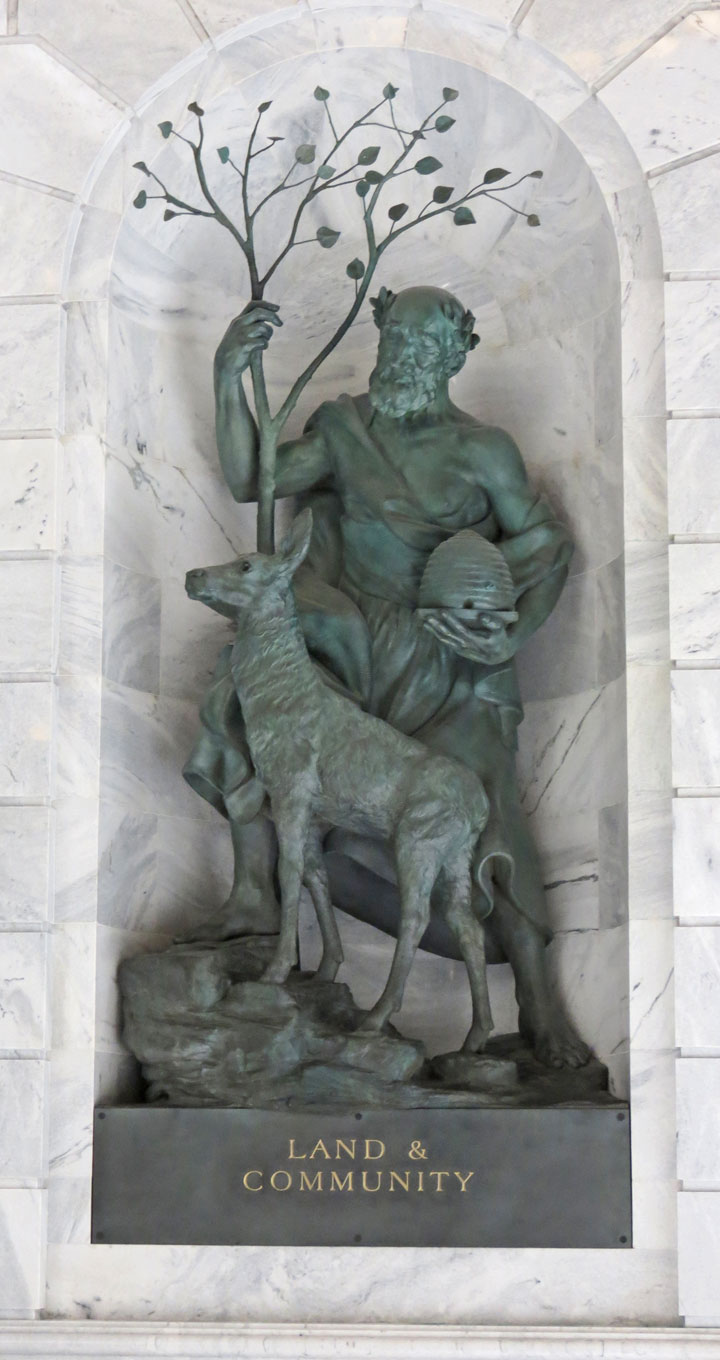
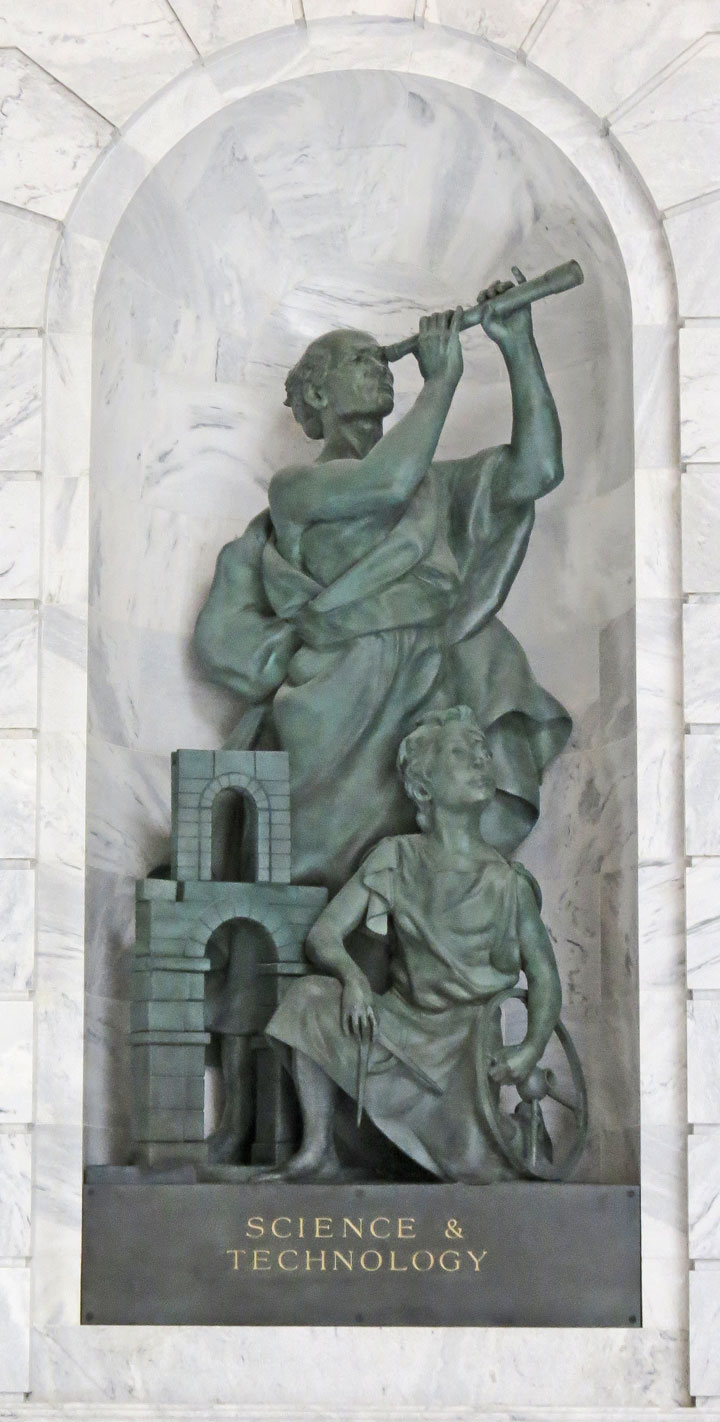
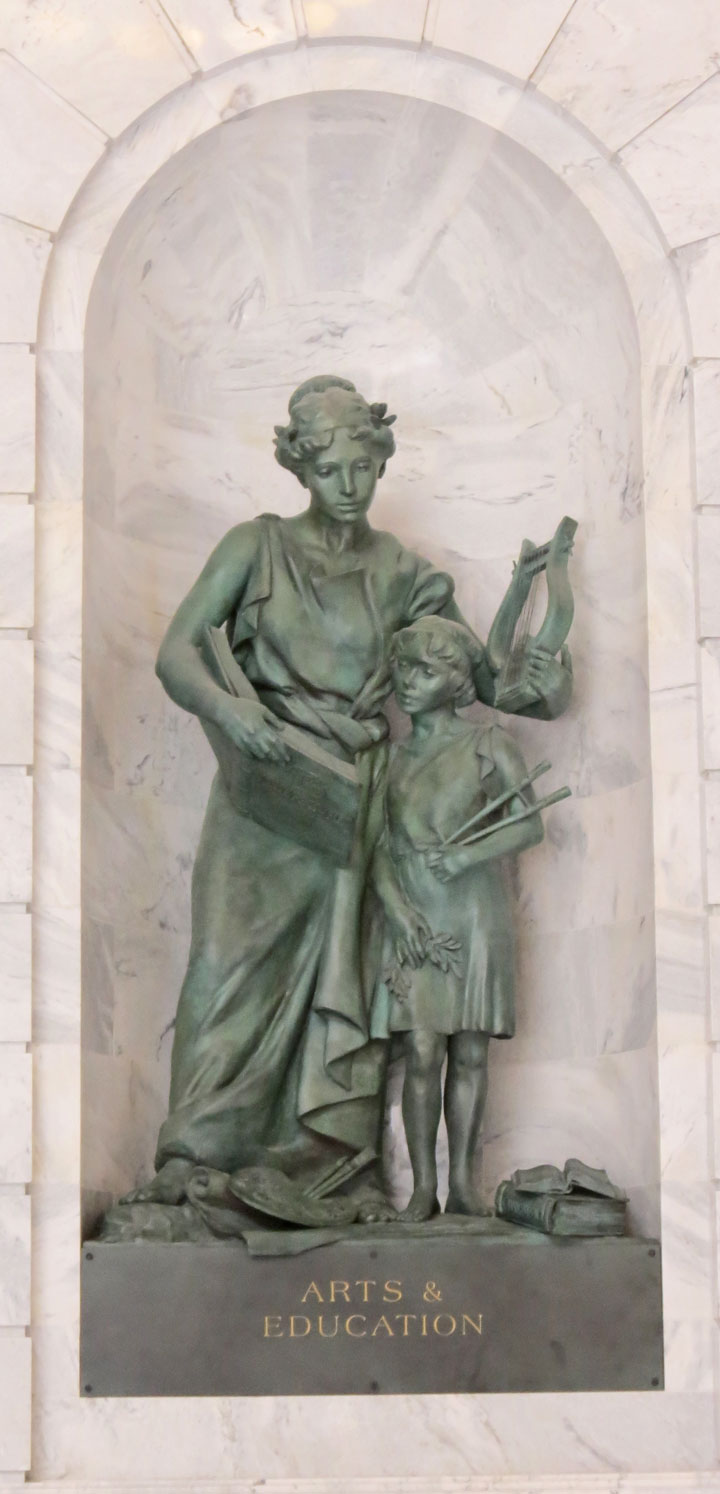
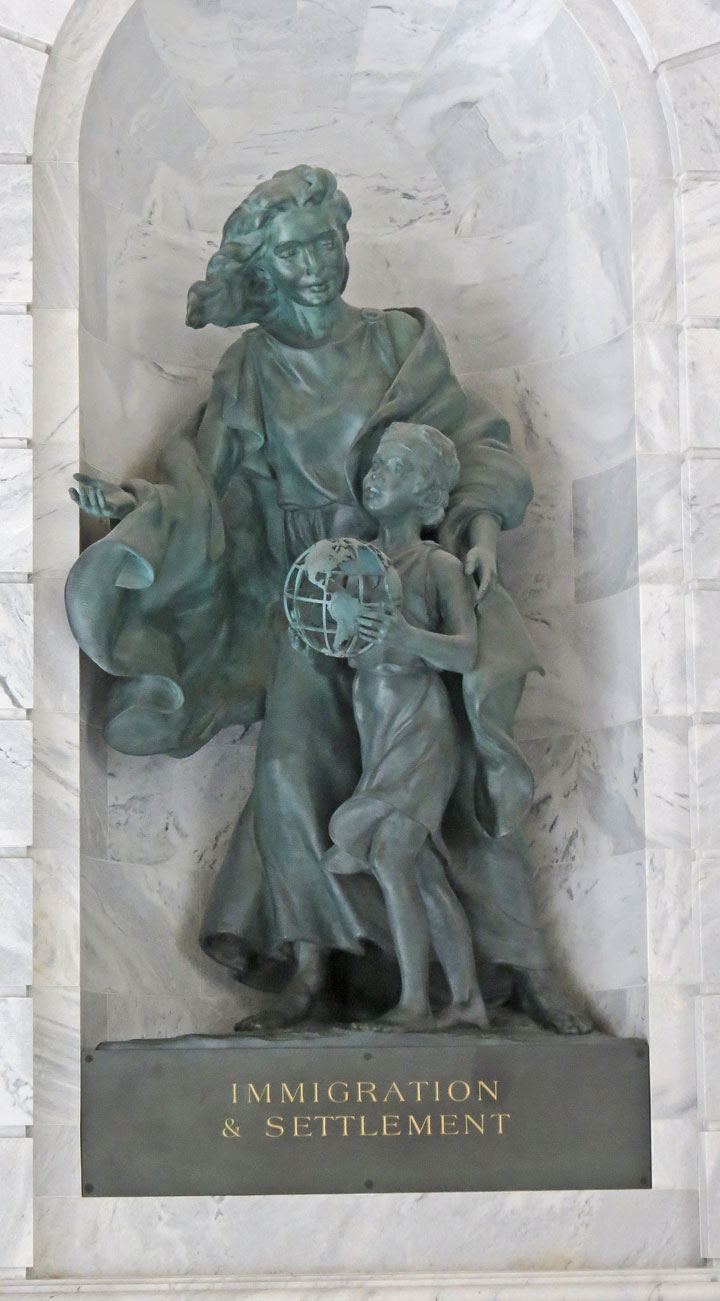
On the east and west sides of the rotunda sit the atrium areas, both of which
contain large skylights, allowing sunlight from outside to enter the public
areas. On all four sides of the open atrium are two levels of mezzanines which
are supported by twenty-four monolithic, Ionic style columns. Each end of the
atriums contain a marble grand staircase, and a mural. The arched mural on the
west end, above the entrance to the House Chamber is entitled the "Passing of
the Wagons", while the east end's mural, above the entrance to the Supreme
Court, is known as the "Madonna of the Wagon". Both murals were meant as a
tribute to the early pioneers, and were the first commissioned works of art in
the capitol, being signed by Girard Hale and Gilbert White.
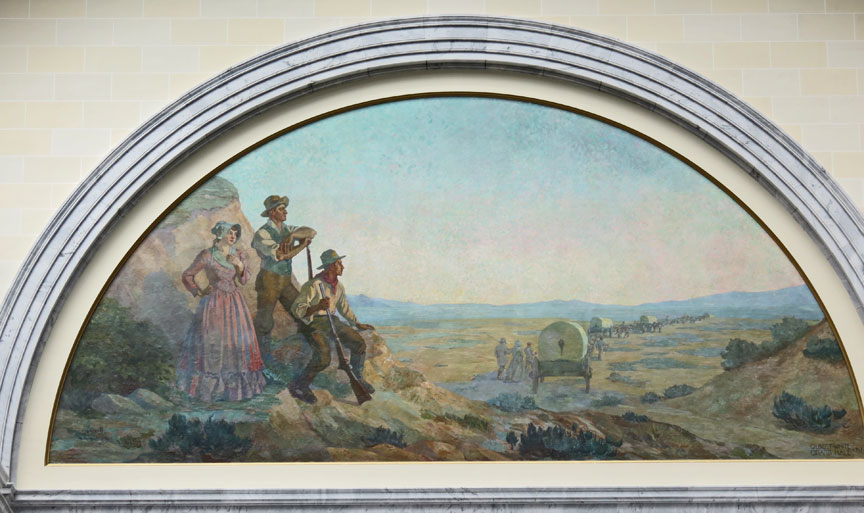
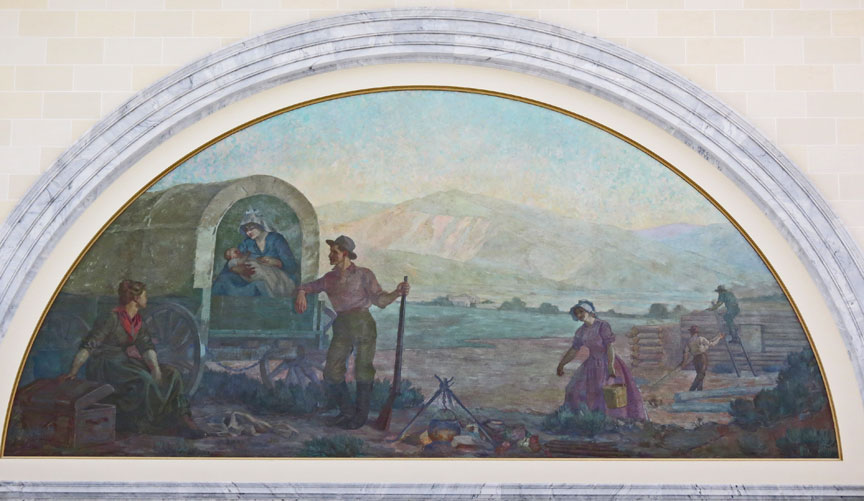
The state reception room, or gold room, is also located on this floor, and is
often used to entertain visiting dignitaries. The gold room gets its name from
the extensive usage of gold leaf in its decoration. On the ceiling of the good
room is painted "Children at Play" by New York artist Lewis Schettle. The
majority of finishing's and furniture in the room have been imported from
Europe, including the Russian walnut table, and several chairs are upholstered
with Queen Elizabeth's coronation fabric. Just west of the gold room, is the
Governor's office.
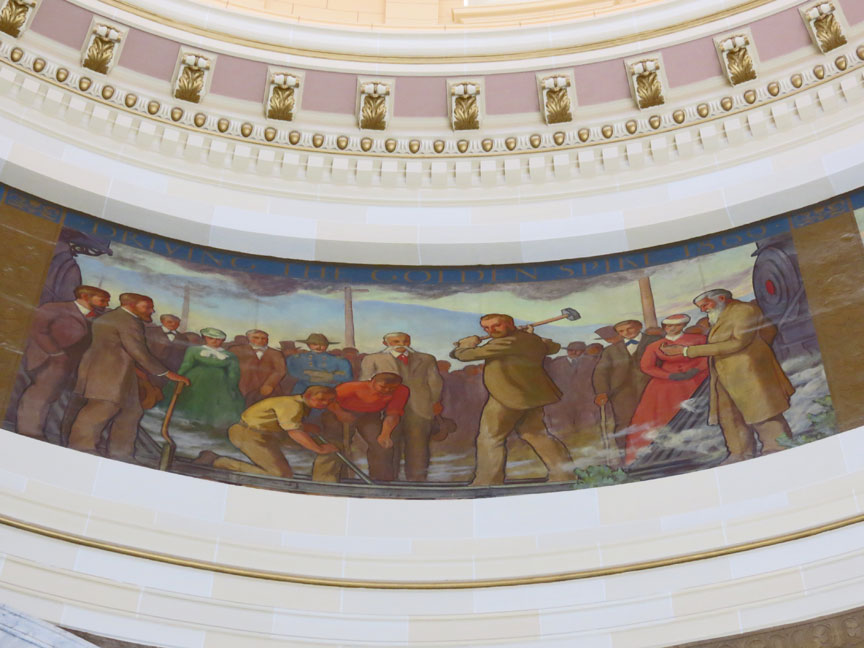
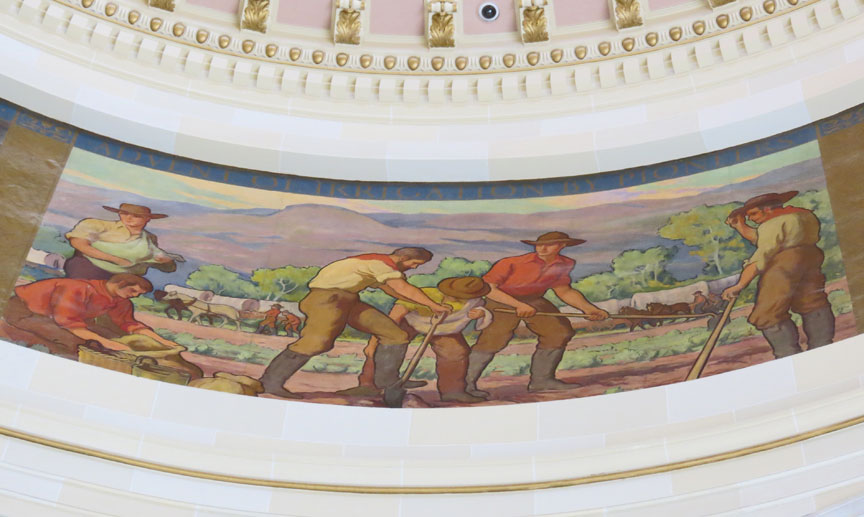

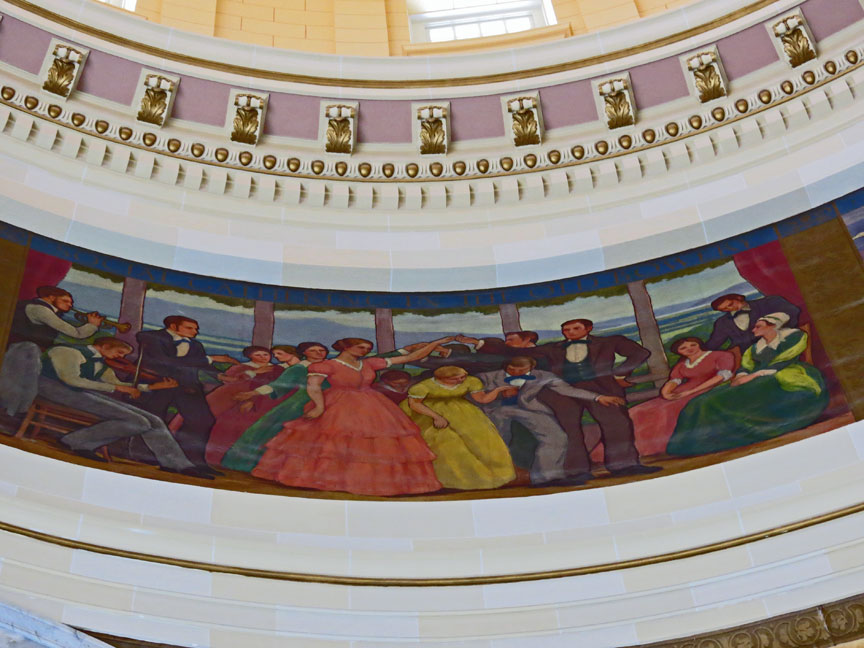
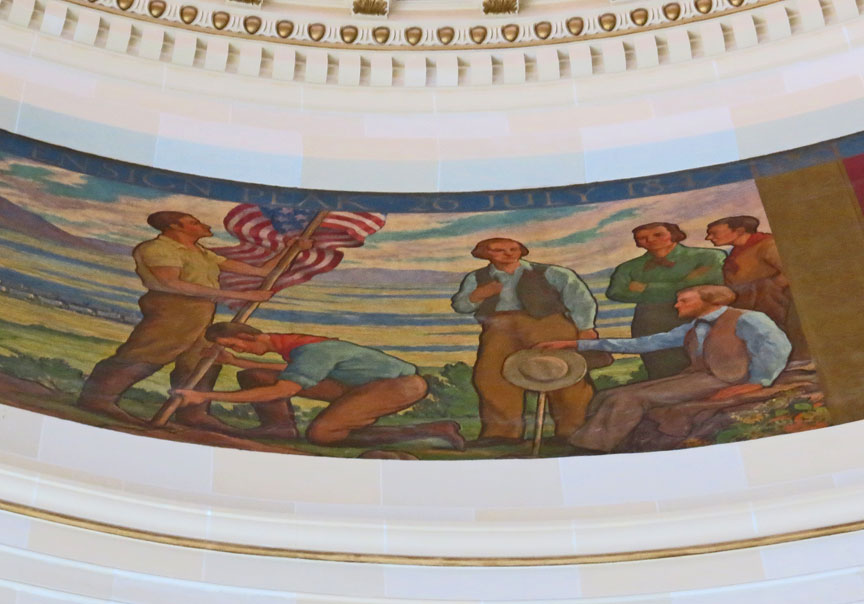
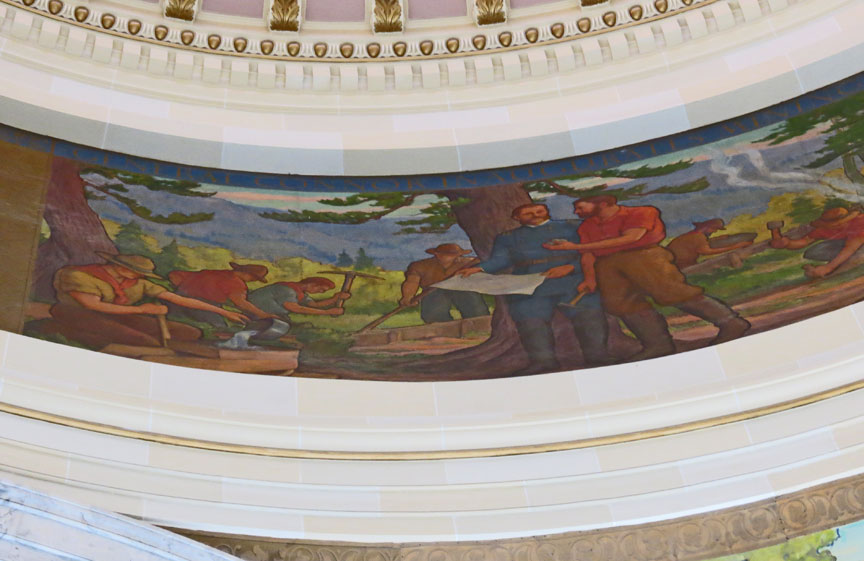
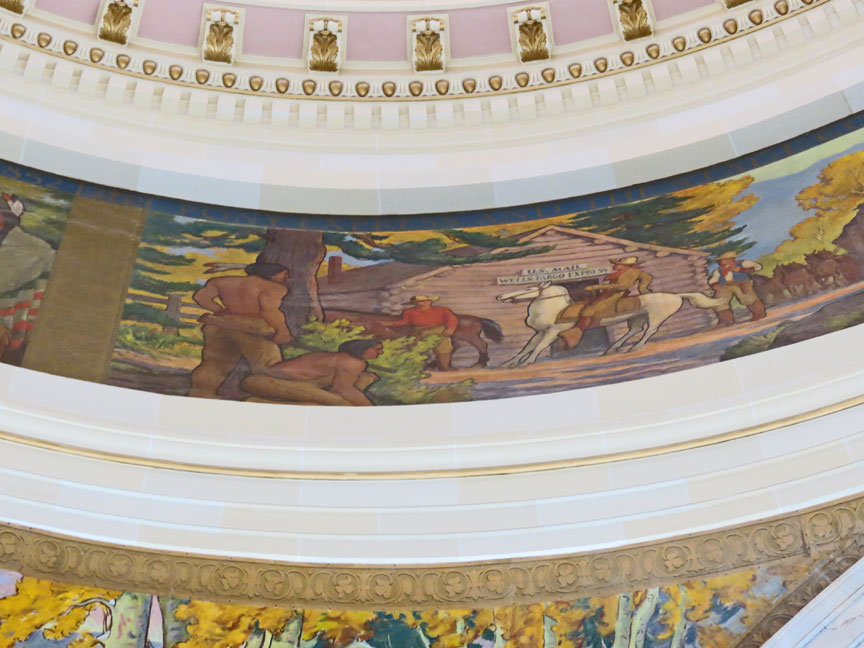
The third floor, also known as the legislative floor, contains the chambers for
both the House and Senate, along with the Supreme Court. When the building was
first completed the north-east corner of this floor contained the library, which
has since been relocated, and the area divided into smaller offices. At the end
of the west atrium area is the entrance to the House of Representatives. The
house is composed of 75 representatives, who serve two-year terms, and represent
approximately 29,000 citizens each. During the restoration the House's chamber
was restored with the original paint colors and period carpets. Two 103 in (260
cm) plasma display screens were installed at the front of the chamber for voting
processes and presentations, a first of its kind system in a state capitol.

elevator
New desks were created, based on the originals, but now allow room for modern technology such as printers and computers. The ceiling of the chamber is a large skylight, allowing natural light to illuminate the room. The chamber also features four murals painted on the rounded ceiling coves, two of which (east and west) are original to the buildings, while the other two were painted during the renovation. The east mural, entitled "The Dream of Brigham Young" was painted by New York artist, Vincent Aderente, and shows Young standing near the Salt Lake Temple and holding their blueprints. The east mural, entitled "Discovery of the Great Salt Lake," shows Brigham Young conversing with Jim Bridger about the Great Salt Lake, and was painted by A. E. Foringer. The north mural features Utah resident, Seraph Young, voting in Utah's first election following the granting of women's suffrage in the territory. The south mural features the Engen brothers building their first Ski jump, representing the importance of outdoor recreation to the economy of Utah. The House Lounge, located directly behind the chamber, was restored to its original size and configuration, and furnished with period carpets and furniture.
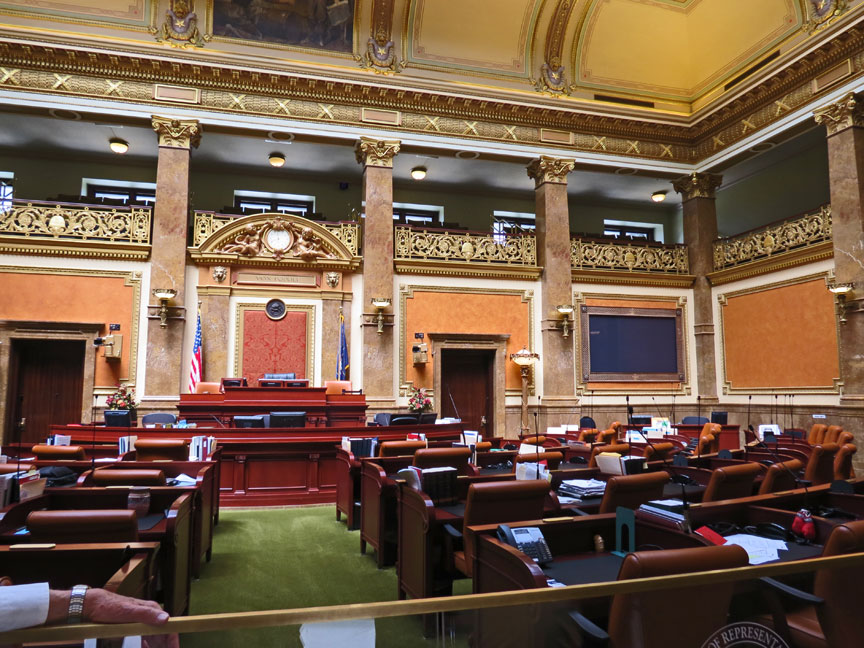
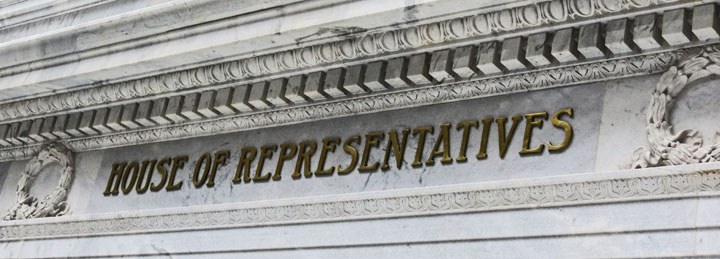
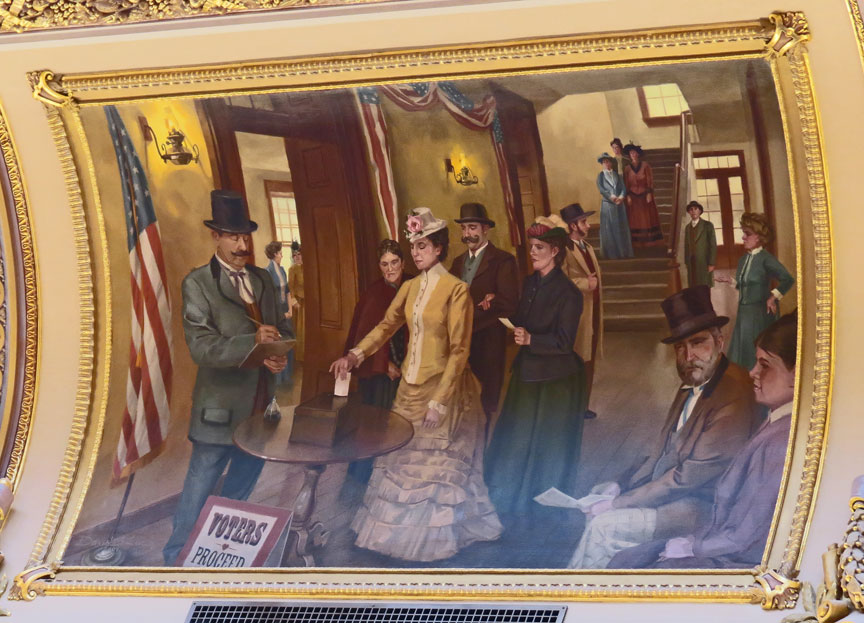
Seraph Young, voting in Utah's first election
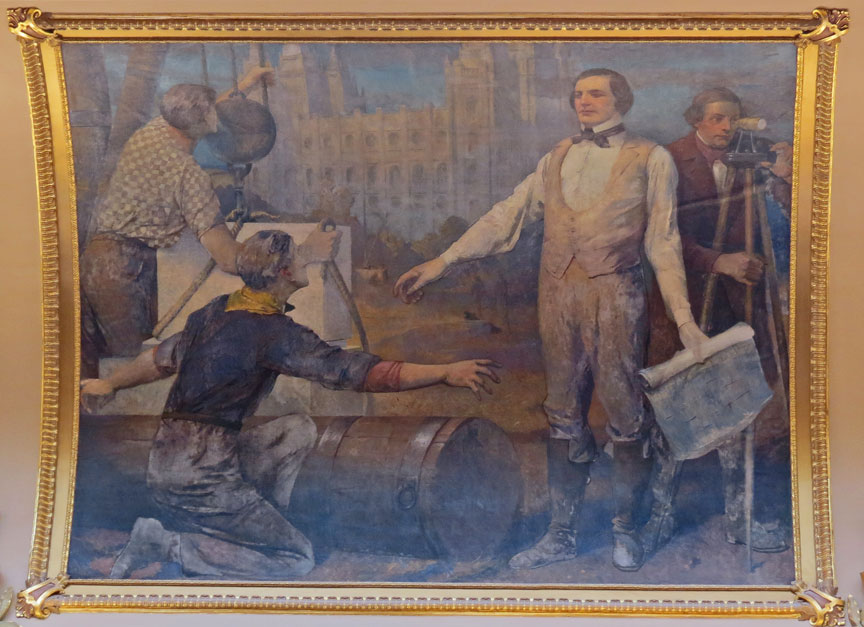
"Discovery of the Great Salt Lake"
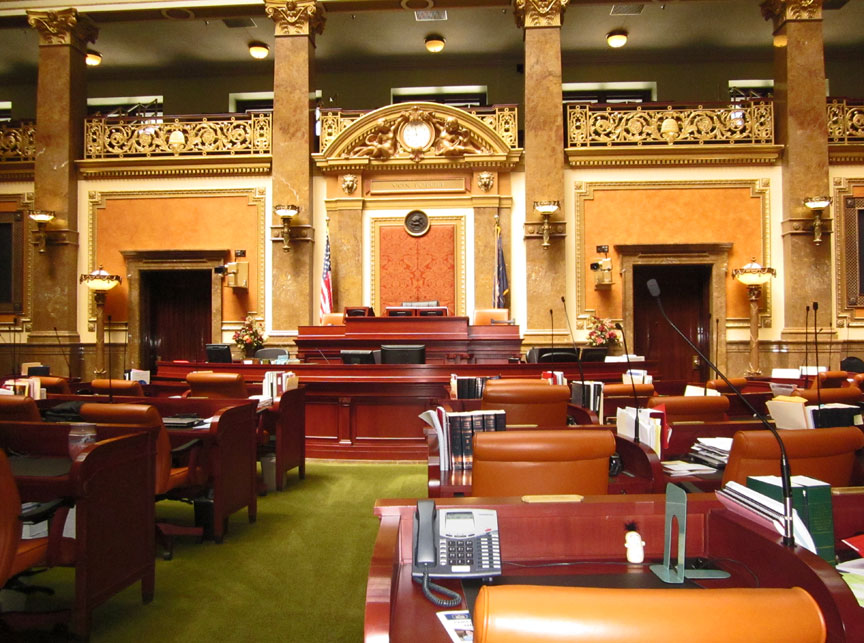

The Senate chamber, which houses the Utah State Senate, is located in the
northern part of the center wing. The Utah State Senate is composed of 29
senators, who serve for terms of four-years. Senators sit facing north, towards
the speaker. The chamber was expanded during the renovation, removing the walls
on each side, opening what were hallways to the floor of the chamber. Like the
House's chamber, the Senate Chamber was restored with original paint colors and
period furniture. Included within the chamber are three murals, the first is
original to the building, and was painted across the entire, upper-part, of the
front wall. The mural, known as a polyptych, is a landscape by A.B. Wright and
Lee Greene Richards showing Utah Lake, located 45 minutes drive south of the
capitol, in Utah County. During the restoration, two new paintings, by Logan
artist Keith Bond were painted. The eastern mural, entitled "Orchards along the
Foothills", shows the Wasatch Mountains of Northern Utah. The western mural,
entitled "Ancestral Home" shows an Anasazi ruin amongst the red-rock hills of
Southern Utah.

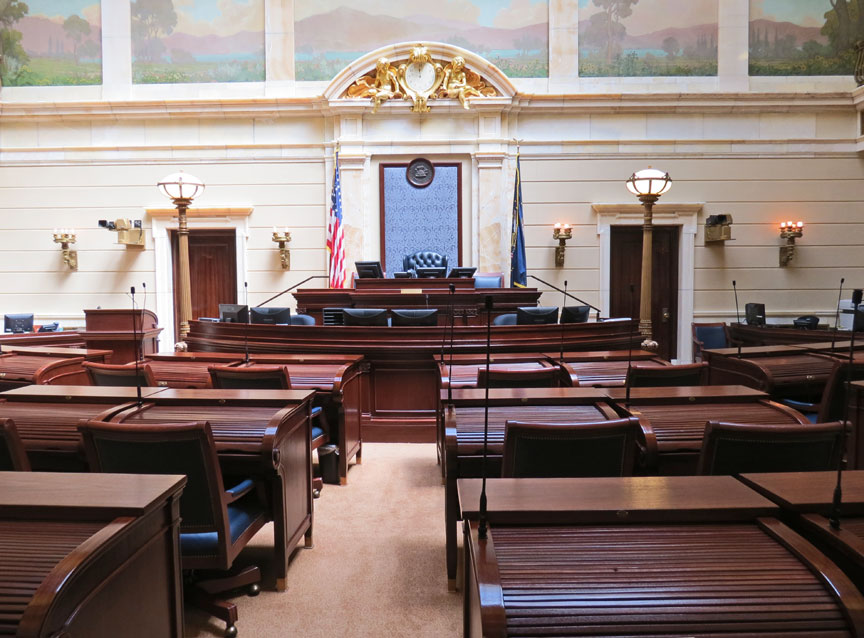
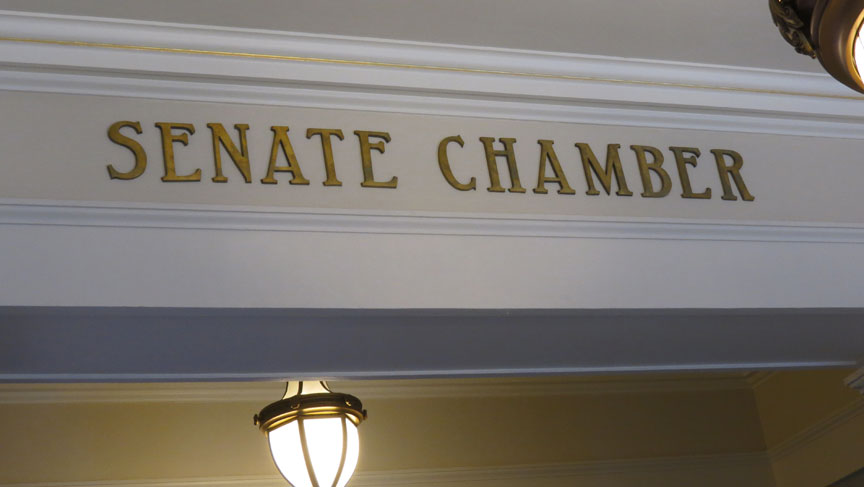
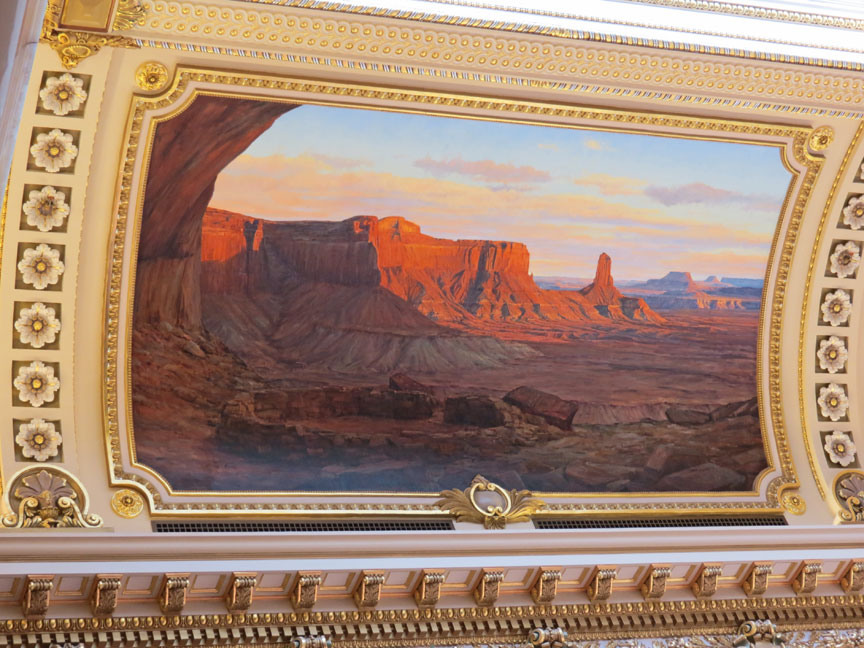
"Ancestral Home", an Anasazi ruin amongst the red-rock hills of Southern Utah.
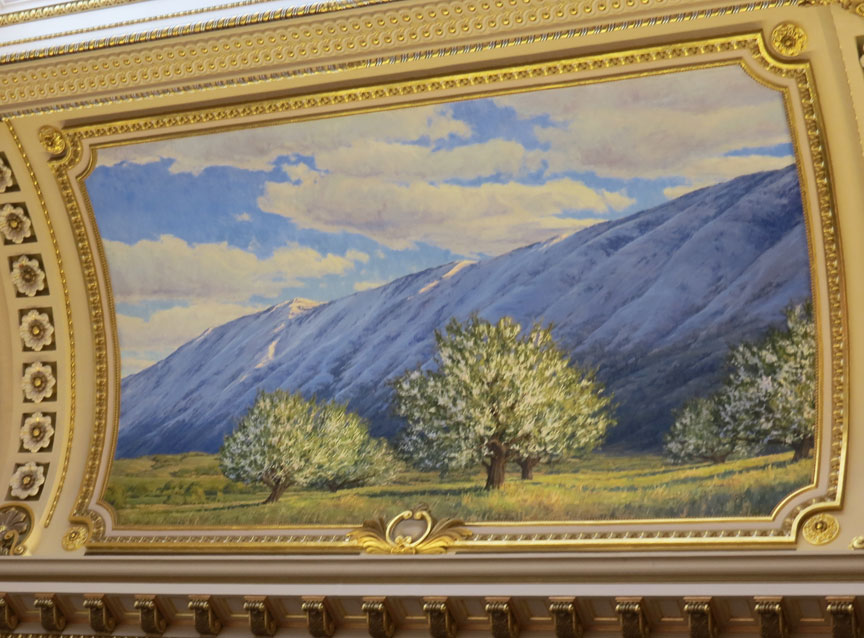
"Orchards along the Foothills"
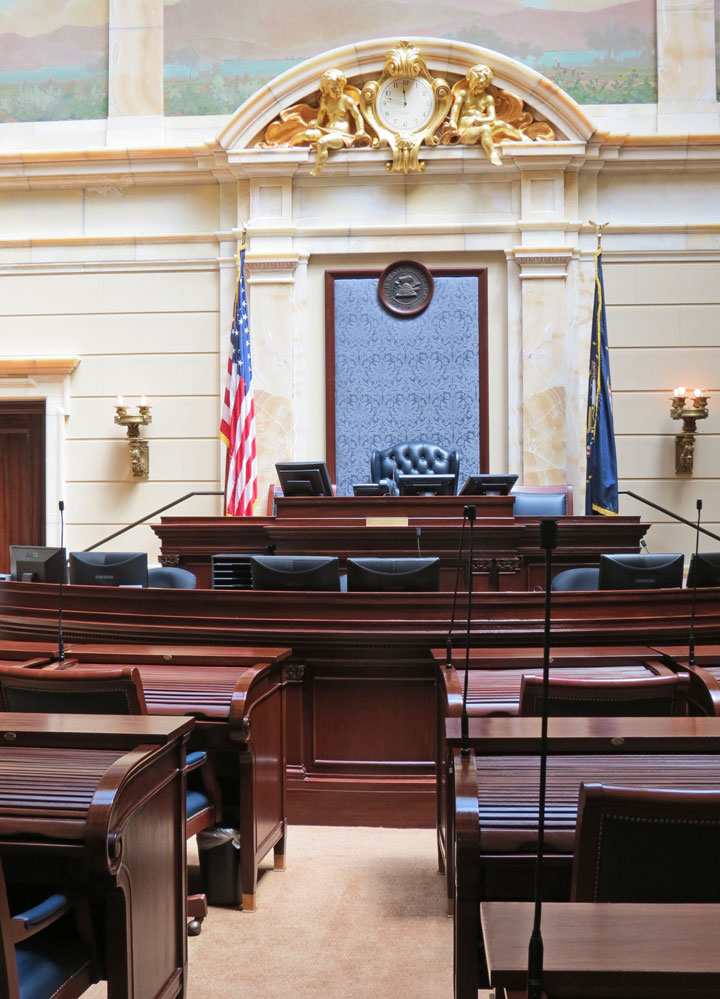
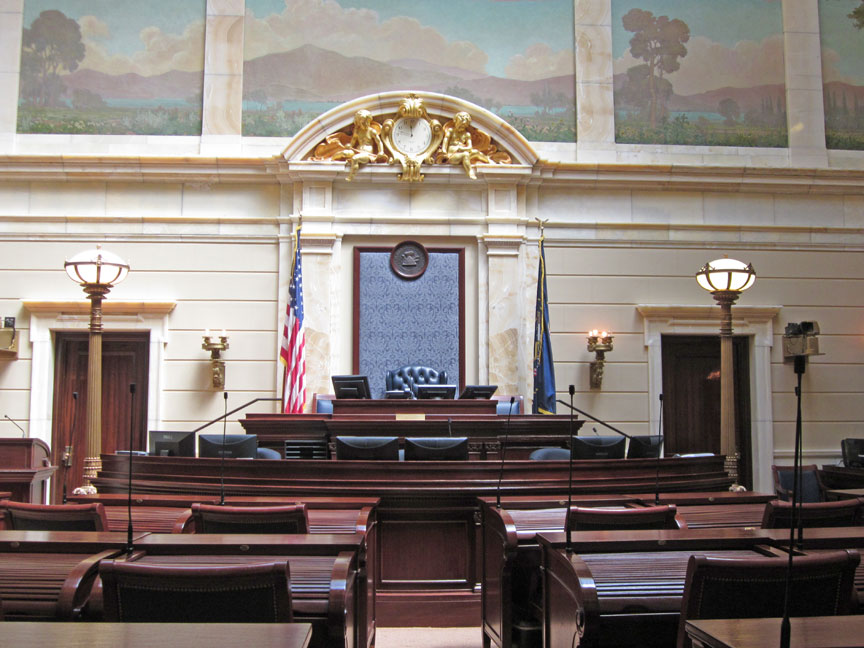
Both historically and after its renovation, the fourth floor contains the
viewing galleries for both the house and senate chambers, along with several
offices and committee rooms. Much of the floor is open to floors below, allowing
visitors to look down on the third or second floors in several locations. When
the capitol originally opened this floor was also used as an art gallery, and
currently it contains several small exhibits along with a statue of Philo
Farnsworth, a developer of television and a Utah native.

Brigham Young


The capitol building is the centerpiece of a 40-acre (160,000 m2) plot which
also includes a Vietnam War memorial and a monument dedicated to the Mormon
Battalion. The renovations added a new plaza, a reflecting pool, and two office
buildings, as well as underground parking. The grounds feature plants, shrubs,
and trees native to Utah, as well as good views of Salt Lake City, the Salt Lake
Valley and the Wasatch Front.
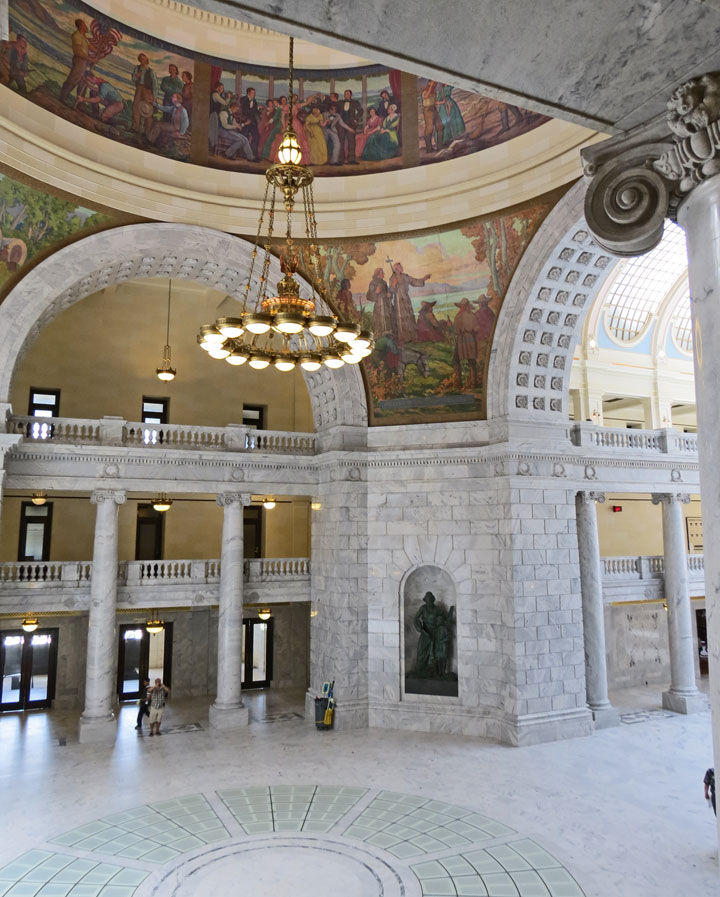
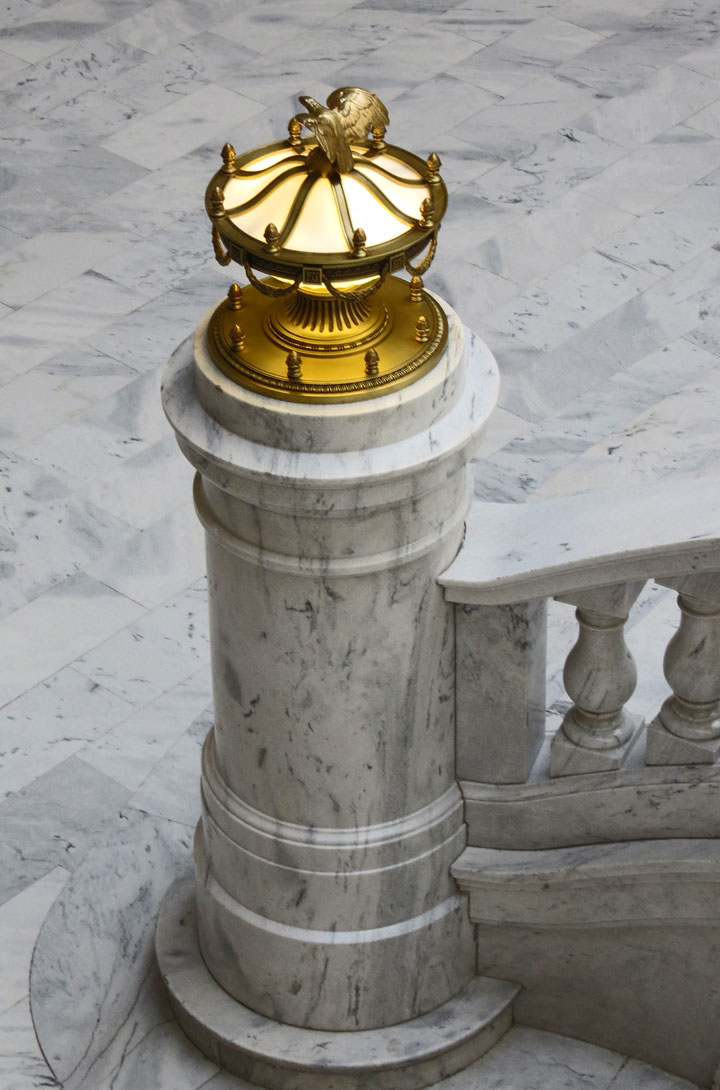
By the 1950s the capitol building was reaching capacity, and there was little
room to expand offices in the capitol without making drastic changes to the
historical layout of the building. As a result the state legislature
appropriated $3 million to construct a new office building, located about 350
feet (110 m) directly north of the capitol. A new master plan was also created
during the design process which specified creating a new plaza which would
connect the two buildings and cover a new underground parking facility. The
other parking lots in the complex were expanded and a maintenance shop was
constructed for state vehicles. The new plan also set aside space for the
construction of two more office buildings on the east and west sides of the
plaza. The new building was designed by Scott & Beecher Architecture, and was
smaller than the capitol building but contained much more usable working space.
The finished plans were completed and presented to the state during November
1958.
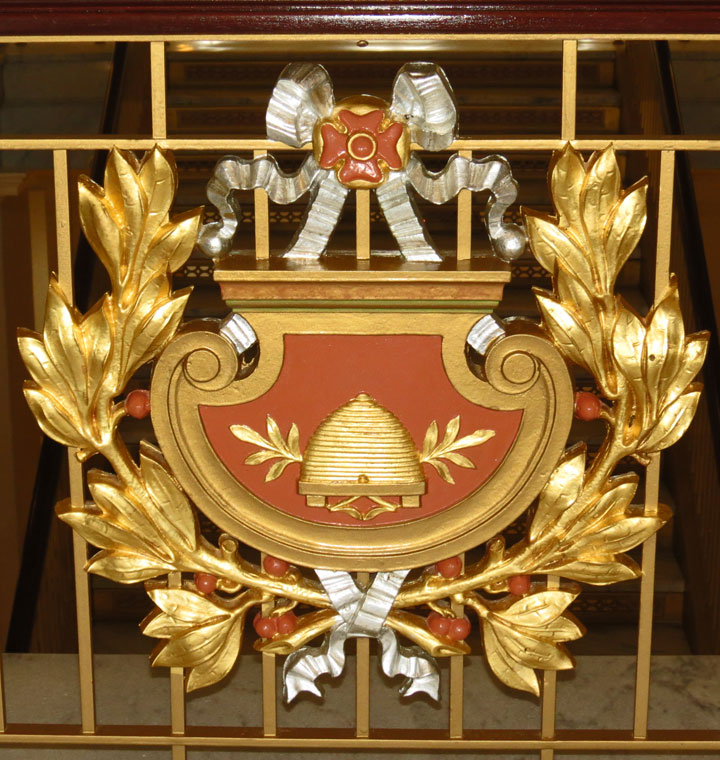
Construction of the new building started with a groundbreaking ceremony held
March 8, 1959. Because the new plan required a large amount of excavation work,
the removed dirt was used to build up the ground for Interstate 15, also under
construction during that period. After the building was completed, it was
dedicated on June 9, 1961.
Text from Wikipedia
